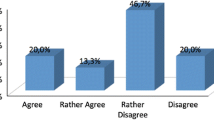Abstract
A recently published framework for the diagnosis of Alzheimer’s disease (AD) in research studies would allow diagnosis on the sole basis of two biomarkers (β-amyloid and pathologic tau), even in people with no objective or subjective memory or cognitive changes. This revision will have substantial implications for future Alzheimer’s research, and the changes should be rigorously evaluated before widespread adoption. We propose three principles for evaluating any revision to diagnostic frameworks for AD: (1) does the revision improve the validity of the diagnosis; (2) does the revision improve the reliability or reduce the expense of the diagnosis; and (3) will the revision foster innovative and rigorous research across populations. The new diagnostic framework is unlikely to achieve any of these goals. Instead, it has the potential to handicap future researchers, and slow progress towards identifying effective strategies to prevent or treat AD.
Similar content being viewed by others
References
Jack CR Jr, Bennett DA, Blennow K, et al. NIA-AA Research Framework: toward a biological definition of Alzheimer’s disease. Alzheimer’s Dement J Alzheimer’s Assoc. 2018;14(4):535–62. https://doi.org/10.1016/j.jalz.2018.02.018.
Ricciarelli R, Fedele E. The amyloid cascade hypothesis in Alzheimer’s disease: it’s time to change our mind. Curr Neuropharmacol. 2017;15(6):926–35.
Brookmeyer R, Abdalla N. Estimation of lifetime risks of Alzheimer’s disease dementia using biomarkers for preclinical disease. Alzheimer’s and Dementia. 2018.
Alzheimer’s Association. 2017 Alzheimer’s disease facts and figures. Alzheimer’s Dementia. 2017;13(4):325–73.
Gu Y, Razlighi QR, Zahodne LB, et al. Brain amyloid deposition and longitudinal cognitive decline in nondemented older subjects: results from a multi-ethnic population. PLoS ONE. 2015;10(7):e0123743.
Howell JC, Watts KD, Parker MW, et al. Race modifies the relationship between cognition and Alzheimer’s disease cerebrospinal fluid biomarkers. Alzheimers Res Ther. 2017;9(1):88. https://doi.org/10.1186/s13195-017-0315-1.
Gottesman RF, Schneider AL, Zhou Y, et al. The ARIC-PET amyloid imaging study Brain amyloid differences by age, race, sex, and APOE. Neurology. 2016;87(5):473–80.
Gottesman RF, Schneider AL, Zhou Y, et al. Association between midlife vascular risk factors and estimated brain amyloid deposition. JAMA. 2017;317(14):1443–50.
Ridker PM. A test in context: high-sensitivity C-reactive protein. J Am Coll Cardiol. 2016;67(6):712–23.
Lee S, Zimmerman ME, Viqar F, et al. Are white matter hyperintensities a core feature of Alzheimer’s disease or just a reflection of amyloid angiopathy? Evidence from the Dominantly Inherited Alzheimer Network (DIAN). Alzheimer’s Dement J Alzheimer’s Assoc. 2016;12(7):P226.
Bennett DA. Mixed pathologies and neural reserve: implications of complexity for Alzheimer disease drug discovery. PLoS Med. 2017;14(3):e1002256.
Schneider JA, Arvanitakis Z, Leurgans SE, Bennett DA. The neuropathology of probable Alzheimer disease and mild cognitive impairment. Ann Neurol. 2009;66(2):200–8.
Stelzmann RA, Norman Schnitzlein H, Reed Murtagh F. An English translation of Alzheimer’s 1907 paper, “Über eine eigenartige Erkankung der Hirnrinde”. Clin Anat. 1995;8(6):429–31.
Hernán MA, Hernandez-Diaz S, Robins JM. A structural approach to selection bias. Epidemiology. 2004;15(5):615–25.
Fardo DW, Gibbons LE, Mukherjee S, et al. Impact of home visit capacity on genetic association studies of late-onset Alzheimer’s disease. Alzheimer’s and Dementia. 2017.
Weuve J, Proust-Lima C, Power MC, et al. Guidelines for reporting methodological challenges and evaluating potential bias in dementia research. Alzheimer’s Dementia. 2015;11(9):1098–109.
Gordon BA, Blazey TM, Su Y, et al. Spatial patterns of neuroimaging biomarker change in individuals from families with autosomal dominant Alzheimer’s disease: a longitudinal study. Lancet Neurol. 2018;17(3):241–50.
Müller S, Preische O, Sohrabi HR, et al. Decreased body mass index in the preclinical stage of autosomal dominant Alzheimer’s disease. Sci Rep. 2017;7(1):1225.
Singh-Manoux A, Dugravot A, Shipley M, et al. Obesity trajectories and risk of dementia: 28 years of follow-up in the Whitehall II Study. Alzheimer’s and Dementia. 2017.
Bateman RJ, Xiong C, Benzinger TL, et al. Clinical and biomarker changes in dominantly inherited Alzheimer’s disease. N Engl J Med. 2012;367(9):795–804. https://doi.org/10.1056/NEJMoa1202753.
Echt DS, Liebson PR, Mitchell LB, et al. Mortality and morbidity in patients receiving encainide, flecainide, or placebo: the Cardiac Arrhythmia Suppression Trial. N Engl J Med. 1991;324(12):781–8.
Ilic D, Neuberger MM, Djulbegovic M, Dahm P. Screening for prostate cancer. London: The Cochrane Library; 2013.
Otis Webb Brawley M, Goldberg P. How we do harm: a doctor breaks ranks about being sick in America. New York: St. Martin’s Press; 2012.
Blendon RJ, Benson JM, Wikler EM, et al. The impact of experience with a family member with Alzheimer’s disease on views about the disease across five countries. Int J Alzheimer’s Disease. 2012. https://doi.org/10.1155/2012/903645.
Health and Retirement Study. Core 2010 public use dataset, experimental module on Alzheimer’s disease attitudes. Ann Arbor, MI: Produced and distributed by the University of Michigan with funding from the National Institute on Aging (Grant Number NIA U01AG009740). 2010.
Food and Drug Administration, Center for Drug Evaluation and Research (CDER), Center for Biologics Evaluation and Research (CBER). Early Alzheimer’s disease: developing drugs for treatment guidance for industry: draft guidance, revision 1. Rockville Maryland U.S. Department of Health and Human Services. 2018.
Author information
Authors and Affiliations
Corresponding author
Rights and permissions
About this article
Cite this article
Glymour, M.M., Brickman, A.M., Kivimaki, M. et al. Will biomarker-based diagnosis of Alzheimer’s disease maximize scientific progress? Evaluating proposed diagnostic criteria. Eur J Epidemiol 33, 607–612 (2018). https://doi.org/10.1007/s10654-018-0418-4
Received:
Accepted:
Published:
Issue Date:
DOI: https://doi.org/10.1007/s10654-018-0418-4



